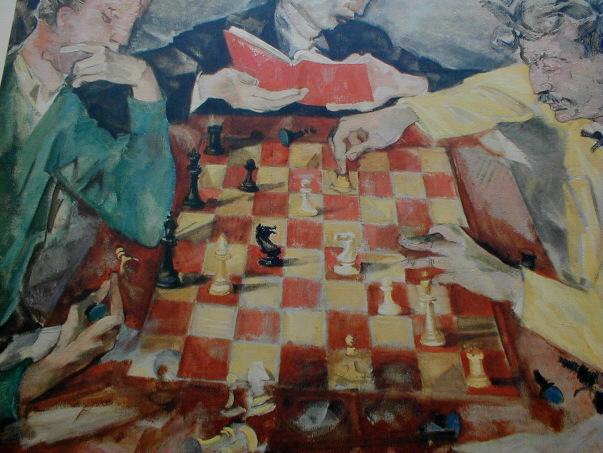Can you think like a Grandmaster ? (updated)

In the position above, Averbakh-Kotov Kotov sacs his Queen on h3 forcing a Kings March. There are a series of precise moves that black makes to keep up the pressure and turn this to a win.
I am playing this against Fritz to help understand what moves need to be made and when. I give the move order below so you can toy around with it as well.
This is a classic case where a side has a material advantage but can't use it. Given this exact position in the game, I hope I would make that Queen sac as black could force a draw if the game appear to be a loss.
(4401) Yuri Averbakh - Alexander Kotov [A55]
Zurich Zurich, 1953
A55: Old Indian Defence with Nf3 and e4 1.d4 Nf6 2.c4 d6 3.Nf3 Nbd7 4.Nc3 e5 5.e4 Be7 6.Be2 0–0 7.0–0 c6 8.Qc2 Re8 9.Rd1 Bf8 10.Rb1 a5 11.d5 Nc5 12.Be3 Qc7 13.h3 Bd7 14.Rbc1 g6 15.Nd2 Rab8 16.Nb3 Nxb3 17.Qxb3 c5 18.Kh2 Kh8 19.Qc2 Ng8 20.Bg4 Nh6 21.Bxd7 Qxd7 22.Qd2 Ng8 23.g4 f5 24.f3 Be7 25.Rg1 Rf8 Black prepares the advance f4 26.Rcf1 Rf7 27.gxf5 gxf5 28.Rg2 f4 29.Bf2 Rf6 30.Ne2 Qxh3+
I am playing this against Fritz to help understand what moves need to be made and when. I give the move order below so you can toy around with it as well.
This is a classic case where a side has a material advantage but can't use it. Given this exact position in the game, I hope I would make that Queen sac as black could force a draw if the game appear to be a loss.
(4401) Yuri Averbakh - Alexander Kotov [A55]
Zurich Zurich, 1953
A55: Old Indian Defence with Nf3 and e4 1.d4 Nf6 2.c4 d6 3.Nf3 Nbd7 4.Nc3 e5 5.e4 Be7 6.Be2 0–0 7.0–0 c6 8.Qc2 Re8 9.Rd1 Bf8 10.Rb1 a5 11.d5 Nc5 12.Be3 Qc7 13.h3 Bd7 14.Rbc1 g6 15.Nd2 Rab8 16.Nb3 Nxb3 17.Qxb3 c5 18.Kh2 Kh8 19.Qc2 Ng8 20.Bg4 Nh6 21.Bxd7 Qxd7 22.Qd2 Ng8 23.g4 f5 24.f3 Be7 25.Rg1 Rf8 Black prepares the advance f4 26.Rcf1 Rf7 27.gxf5 gxf5 28.Rg2 f4 29.Bf2 Rf6 30.Ne2 Qxh3+
Updated: Fritz saw this line that it liked when it analysed the info last night. The play is a series of checks with some of inbetween move to better blacks attacking position. ( I still need to further study this)
31.Kxh3 Rh6+ 32.Kg4 Nf6+ 33.Kf5 Nh5 34.Rg5 Rf8+ 35.Kg4 Nf6+ 36.Kf5 Ng8+ 37.Kg4 Bxg5 38.Qe1 Nf6+–+ -6.41/19 Line
This is a rather famous game and can be found here and with detailed annotation here at Life Masters AJ site ( an interesting site). It also appears in the Art of Attack chapter 2.


8 Comments:
At 2:11 PM, Kaan Kara said…
Kaan Kara said…
Actually i should admit i didn't controlled but if qxh3+ accepted then rh6+ kg4(only move) nf6+ kg5(only move) and rh5# should be the mate... after leaving the comment i will check it again, please forgive me for if any incorrect information is given by me
At 2:12 PM, Sir Nemo said…
Sir Nemo said…
Well without loading up Fritz(due to the lack of owning it =P), i would say that 1)...Qxh3+ 2)Kxh3 Rh6+ 3)Bh4 Rxh4# seems pretty decisive. Of course, assuming White takes the Queen on the sac. I played a similar sac last night at the club.
At 2:13 PM, Kaan Kara said…
Kaan Kara said…
sorry if bh4 is played for an option to kg4, simple capturing it by rook mates...
At 2:14 PM, Kaan Kara said…
Kaan Kara said…
i am sorry nemo i ddin't see your reply :(
At 10:11 PM, Anonymous said…
Anonymous said…
Kaan KARA said:
"if qxh3+ accepted then rh6+ kg4(only move) nf6+ kg5(only move) and rh5# should be the mate...".
-- After ...Nf6+ can't White's king go to f5? And then after that the White king would have e6 as another possible flight square, so it seems like the king hint will go on for at least a few more moves.... (I hope I didn't set up the position incorrectly when I played through those moves..).
Best, Hank
At 2:29 AM, takchess said…
takchess said…
Kaan,Nemo and Hank,
thanks for commenting. The mate is not quite that quick. I put a couple of links and revised the posts for future info on the lines and the game.
At 7:16 PM, Unknown said…
Unknown said…
I had Rybka play out its best line from the position in your diagram (starting with 30...Qxh3+), and after 20 more moves Black was up a rook + a pawn, but mate was still many moves away...
(I let Rybka think to at least 16 ply at each move, sometimes as much as 20 ply.}
-- Hank
p.s.: Here's that PGN:
==
[Event "?"]
[Site "?"]
[Date "2008.02.01"]
[Round "?"]
[White "New game"]
[Black "Rybka 2.3.2a 32-bit"]
[Result "*"]
[SetUp "1"]
[FEN "1r4nk/1p1qb2p/3p1r2/p1pPp3/2P1Pp2/5P1P/PP1QNBRK/5R2 b - - 0 1"]
[PlyCount "38"]
{starting at 30...Qxh3+} 1... Qxh3+ 2. Kxh3 Rh6+ 3. Kg4 Nf6+ 4. Kf5 Nd7 5. Rg5
Rf8+ 6. Kg4 Nf6+ 7. Kf5 Ng8+ 8. Kg4 Bxg5 9. Qe1 Nf6+ 10. Kf5 Ng4+ 11. Kxg4 Rg8
12. Kf5 Bd8 13. Bh4 Rhg6 14. Bg5 Bxg5 15. Rg1 Rf6+ 16. Kg4 Bh4+ 17. Kh3 Bxe1
18. Rxg8+ Kxg8 19. Kg2 Rg6+ 20. Kh1 *
==
At 4:21 AM, takchess said…
takchess said…
Thanks Hank,
I am playing this against position against the computer and it is instructive. Some black moves which seem sensible are leading to draws and sometimes losses. The trick is to move his king but the light square diagonal while slowly moving your pieces to better squares. I am also seeing why some of whites moves are forced which are not intuitive to me.
This game is from the Zurich Tournament which Bronstein annotated. I have that book so I am going to see what he says which is always fun.
Post a Comment
<< Home